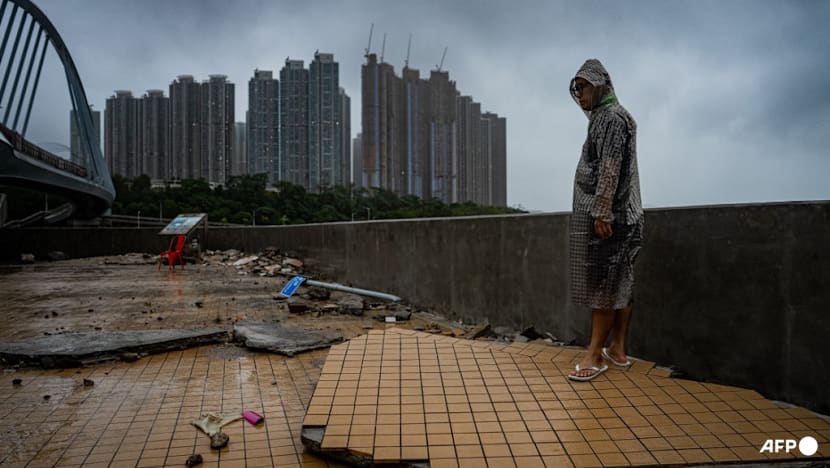Hong Kong seeks innovative green solutions to tackle climate change, extreme weather
Experts caution that sluggish progress risks derailing Hong Kong’s climate targets, leaving the city more vulnerable to extreme heat, rising sea levels and increasingly severe storms.

A man stands on a damaged pavement in Tseung Kwan O after Super Typhoon Ragasa hit Hong Kong on Sep 24, 2025. (Photo: AFP/Leung Man Hei)

This audio is generated by an AI tool.
HONG KONG: In a dense city with limited space to plant more trees, one start-up in Hong Kong is offering a promising alternative to curb carbon emissions.
Biotechnology firm Alcarbo Technologies has developed algae photobioreactors, or “algae walls”, that can capture carbon dioxide at rates far exceeding those of trees.
Unlike trees, which are vulnerable to being uprooted during typhoons and heavy rain, these panels remain firmly in place — a crucial advantage in a city prone to extreme weather.
While a tree can typically capture around 10kg to 30kg of CO2 annually, each algae wall can capture 329kg of CO2 per year, “which is much more than planting trees”, noted Nelson Ang, co-founder of Alcarbo Technologies.
The company is targeting heavy emitters such as manufacturing, power suppliers and logistics firms, he said.
“We target those companies because they are the main source of the carbon emissions, and we want to try to help them to tackle these challenges,” he added.
Such innovations could play a key role in helping Hong Kong meet its climate action plan, which sets ambitious goals to cut emissions and promote sustainability.
CLIMATE DEFENCE STRATEGY
But experts caution that sluggish progress risks derailing those targets, leaving the city more vulnerable to extreme heat, rising sea levels and increasingly severe storms.
In the first eight months of this year, the city has already been hit by four typhoons — compared with none during the same period last year.
This comes on top of the city’s regular typhoon season, which typically runs from June to October.
Most recently, Super Typhoon Ragasa brought Hong Kong to a standstill about a week ago.
At the same time, Hong Kong is grappling with rising temperatures — a trend expected to worsen as global greenhouse gas emissions continue to climb.
“Based on a wide range of assumptions about the greenhouse gas emissions in the future, like in the summer time, the average temperature will increase by about 1 to 3 degrees Celsius for Hong Kong,” said Professor Gao Meng of the Hong Kong Baptist University’s department of geography.
“If we further consider the impacts of humidity, these numbers can be greater, by about 1.6 to 3.5 degrees Celsius for Hong Kong. That's a huge change.”
The Hong Kong government has set a target for renewable energy to supply up to 10 per cent of the city’s electricity within the next decade.
Yet in 2022, renewables accounted for only 0.9 per cent of total power generation, according to the International Energy Agency (IEA).
Some observers remain doubtful that the government will meet its goal.
Karen Ho, head of corporate and community sustainability for non-profit organisation WWF Hong Kong, said the city’s building energy code and new building requirements currently lack clear measures to ensure developers incorporate renewable energy systems into new projects.
ECO-FRIENDLY PLANS
Meanwhile, Hong Kong is embarking on a massive development in the north — the Northern Metropolis mega project.
Vast stretches of green space near the city’s border with tech hub Shenzhen in mainland China will soon give way to redevelopment.
Some, however, have urged the authorities to seize this opportunity to make the project a showcase for eco-friendly plans.
This includes constructing green buildings designed to consume less energy — developments that could serve as role models for future projects across Hong Kong.
The government has promised nature protection initiatives, including a new wetland conservation park, as part of the Northern Metropolis development.
But so far, details remain scarce.
Environmentalists hope that sustainability measures will not just be an add-on, but will be woven throughout the entire project.
They stressed that urban development need not come at the expense of the environment, and that balancing both would allow the city of 7.5 million to play a responsible role in tackling global warming.
Ho from WWF Hong Kong said that all new building and infrastructure projects should be planned with the net-zero concept in mind.
This means factoring in the entire life cycle of the development from the start, and ensuring that it is resilient to potential vulnerabilities, she noted.
“Then for the nature side which could be an ally for combating climate change, we hope that all the new development will have zero extinctions of any nature.”



















